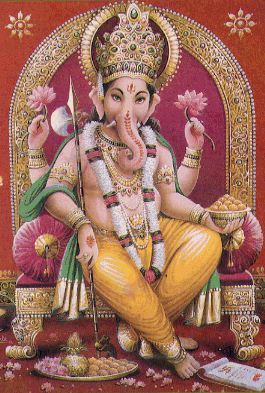

Upper left hand with or without a noose : Stands for Creation Lower right hand with or without the broken tusk : Stands for Protection that gives Fearlessness Lower left hand with or without a modaka (laddu) : Stands for Grace that gives Liberation The Trunk ( organ of smell and touch) stands for obliteration or deception ( Maya). |
| There is no other God or Divinity in the entire Hindu pantheon who has such a variety of interpretations and such a spectrum of legends as those associated with Lord Ganesa. He is one of the six major Divinities of Hinduism, namely: Surya, Sakti, Vishnu, Ganesa, Subrahmanya and Siva. However, He is the one Divinity who is always invoked at the commencement of any worship. Be it a secular function, a religious ritual, a marriage ceremony, an auspicious undertaking or any individual or collective enterprise, He is propitiated first in order to have all obstacles removed. There is no greater authority than Ganapati. Worshippers of other Divinities have to worship Him first. But to worship Him one is not obliged to worship any other deity. He is the Lord Special. Therefore He is Vinaayaka. Every thing about Him has an esoteric or philosophical meaning in addition to the mundane legends associated with him. | In worshipping Ganapati,
the devotee cuffs the head with a closed fist five times, uttering
His five names and prays for removal of all obstacles.
The five names and prayer run thus : S:Ø´aöb:rMD:rö M He who is clad in pure white ev:\N:Øö M He who is all-pervasive S:eS:v:N:üö M He who is the colour of the Moon c:t:ØB:Øüj:ö M He who has four hands )s:Àv:dn:ö M Of an ever happy face Dy:ay:ðt:Î s:v:ü ev:Gn:<p:S:ant:y:ð May He remove all obstacles |
| He is the Absolute Vinaayaka is the embodiment of Om or AUM, the subtle symbol for the Absolute. With his right tusk broken,this elephantine Divinity represents the female principle by his right half and the male principle by his left half.So He represents the Transcendental Absolute which is beyond sex. The Absolute is also beyond Man and Animal and Vinaayaka signifies this by his animal face and human limbs. The Absolute is the Overlord of all the senses and their activities. So also Ganapati is the chief of all Ganas( divine soldiers)who constitute the dynamics of divine action and management. Gana also means categor.Ganapati is the Lord of the category of comprehension or consciousness. Though He holds the Modaka in his hand His trunk is never shown as putting the Modaka in His mouth. He just holds them. He watches. He is witness(= Saakshi) to everything. He does not Himself consume or experience. He is the witness of consciousness in each one of us.He is the symbol of Primordial Power of consciousness. |
| He is the Lord of Obstacles, therefore Vigna-Iswara, ev:Gn:=ISvar, not the queller of obstacles-- for in that case His name would have been Vighna -ghn- eswara, ev:Gn:=Gn:=ISvar. So His name signifies He is at the same time the creator of obstacles and also the remover of them. He creates obstacles in order that people may shed their egoism (Ahamkara) and think of God with humility. When one thinks of Him with humility, He removes the obstacles to success and gives us siddhi , success or fulfillment and buddhi, Inteligence. In fact His two energy-consorts bear the names Siddhi and Buddhi. |
| His elephant-head is adored as the symbol of wisdom. Seated on the tiny mouse shows His mastery over everything - from the macro to the micro, and stands for the wisdom of comprehension spanning all from the micro to the maicro. The whole figure of Vinayaka with the Modaka (sweet dish) in the hand and the pot-belly stands for the contentment that comes of wisdom. It is the spiritual contentment of the fullness of the Absolute. The pot-belly also signifies that the entire universe is within Him. It is this contentement that makes Him dance sometimes. There are innumerable images and artistic representations of the dancing Ganapati. | s:v:üö
j:g:eddö tv::< j:y:t:ð tv::¡sT:Äet: tv:ey:
l:y:ö O\y:et: tv:ey: )t:y:ðet: tv:ö
B:Üem:Mrap:<Mn:l:< en:l:< n:B:H tv:ö g:ØN:*:y:at:it:H
tv:ö dðh*:y:at:it:H tv:ö kal:*:y:at:it:H tv:ö b:ÒÉ
tv:ö ev:\N:Øtv:ö EndÓ tv:ö A¡gn:
tv:ö v:ay:Ø tv:ö s:Üy:ü c:ndÓm:a tv:ö b:ÒÉ B:ØB:Øüv:s:Øv:r<m:Î All this Universe springs from you, stands in you, merges in you and returns back to you. You are Earth, Water, Fire, Windand Space and you transcend the three Gunas (Sattva, Rajas, Tamas). You transcend the three States (Physical, Subtle and Causal) You transcend the three phases of Time (Past, Present and Future) You are Brahma, You are Vishnu You are Indra, You are Agni, Vayu, Sun and Moon and the three Vyaahritis, and OM the Absolute Brahman ---- From Ganapati Upanishad - Atharva Veda |
| j:<
s:Øem:rX es:e¹ h<E g:N: n:ay:k kerb:r b:dn:
K:rau An:Øg:Òh s:<E b:Øe¹ raeS: S:ØB:a g:ØN: s:dn: --- Ram Charit Manas of Tulsidas |
May Lord Ganesa, the leader
of Siva's retinue whose very thought ensures success, who carries on his
shoulders the head of a beautiful elephant, who is a repository of wisdom,
and an abode of
blessed qualities, shower His grace ! --- Ganpati Bappa Maurya ...... |